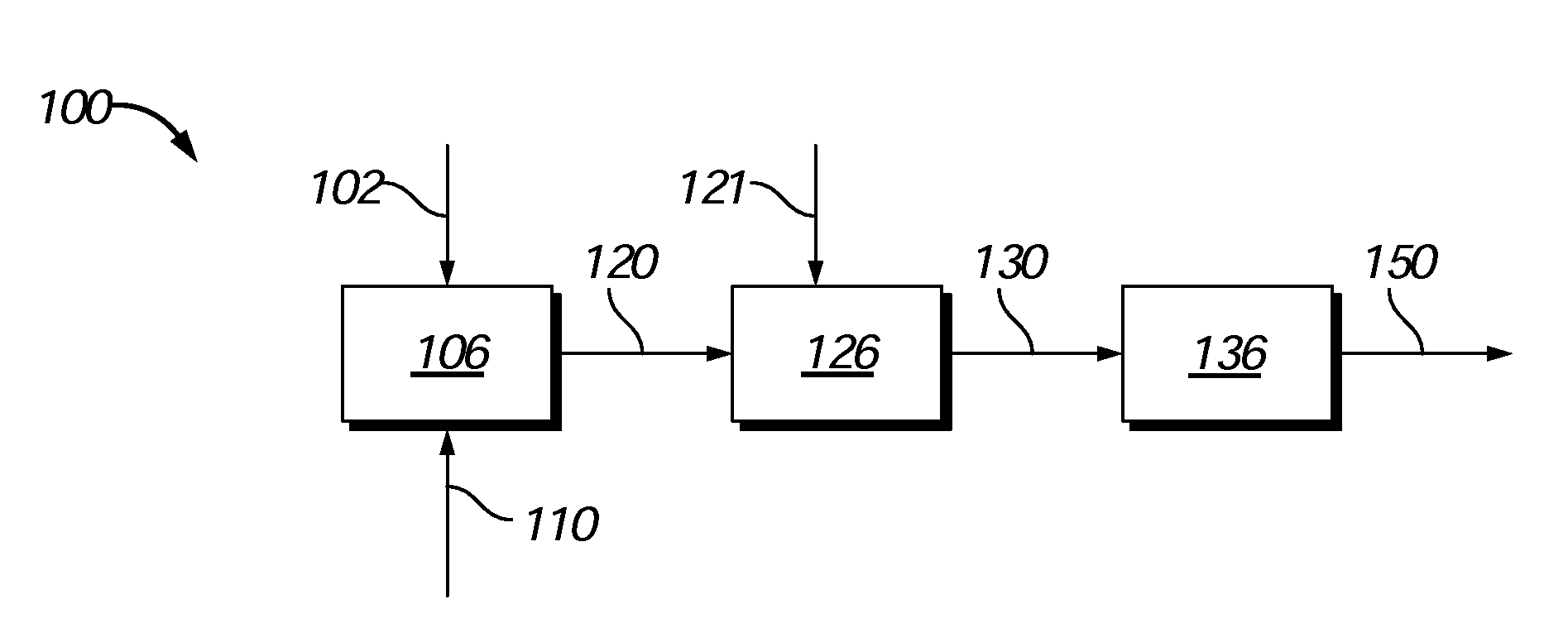Process to produce biofuels from biomass
- Summary
- Abstract
- Description
- Claims
- Application Information
AI Technical Summary
Benefits of technology
Problems solved by technology
Method used
Image
Examples
examples
[0128]Reaction studies were conducted in a Parr5000 Hastelloy multireactor comprising 6×75-milliliter reactors operated in parallel at pressures up to 135 bar, and temperatures up to 275° C., stirred by magnetic stir bar. Alternate studies were conducted in 100-ml Parr 4750 reactors, with mixing by top-driven stir shaft impeller, also capable of 135 bar and 275° C. Larger scale extraction, pretreatment and digestion tests were conducted in a 1-Liter Parr reactor with annular basket housing biomass feed, or with filtered dip tube for direct contacting of biomass slurries.
[0129]Reaction samples were analyzed for sugar, polyol, and organic acids using an HPLC method entailing a Bio-Rad Aminex HPX-87H column (300 mm×7.8 mm) operated at 0.6 ml / minute of a mobile phase of 5 mM Sulfuric Acid in water, at an oven temperature of 30° C., a run time of 70 minutes, and both R1 and UV (320 nm) detectors.
[0130]Product formation (mono-oxygenates, glycols, diols, alkanes, acids) were monitored via ...
examples 1-6
Poisoning of Platinum Catalysts
[0132]A set of experiments were conducted in the Parr5000 multi-reactor filled with 20-grams of 50% glycerol in deionized water a supported platinum catalyst (0.35-grams of 5% Pt / alumina (Escat™ 2941 from Strem Chemicals, Inc., or 0.15 grams of a 1.9% Pt / zirconia modified with rhenium at Re:Pt rato of 3.75:1 prepared by the method according to US2008 / 0215391, Example 7. Varying amounts of N,S-amino acid cysteine, or N-amino acid alanine, were added to assess impact on rates. Reactors were pressured to 500 psig of H2, with heating to 255° C. for 6.5 hours. Unconverted glycerol was determined by HPLC analysis, and by GC analysis using the DB5-ox method, while reaction products from showed convertion to propylene glycol, isopropanol, and n-propanol intermediates.
[0133]A first order reaction rate was calculated relative to the weight fraction of catalyst in liquid solution (Table 1). Results indicated strong sensitivity to both N and N,S amino acids for th...
examples 7-9
Ru / Silica Poisoining
[0134]The experiment of Examples 1-6 were repeated at 240° C. with 5% Ru / silica catalyst (x-Engelhard Corp., Inc.) and a feed solution of 33.7 wt % glycerol. Fresh catalyst gave a rate of glycerol conversion of 1.85 l / h / wt-catalyst (Example 7). Addition of 7.5% by weight of N,S amino acid cysteine relative to catalyst, gave an activity that was only 8.5% of fresh, unpoisoned catalyst activity (Example 8). Addition of only 1.3% cysteine relative to catalyst resulted in a glycerol conversion rate that was 11.5% of fresh, unpoisoned catalyst (Example 9). These results indicated strong poisoning of glycerol or sugar alcohol hydrogenolysis or hydro-deoxygenation, by small amounts of N,S-containing amino acid.
PUM
| Property | Measurement | Unit |
|---|---|---|
| Temperature | aaaaa | aaaaa |
| Temperature | aaaaa | aaaaa |
| Condensation enthalpy | aaaaa | aaaaa |
Abstract
Description
Claims
Application Information
 Login to View More
Login to View More - R&D
- Intellectual Property
- Life Sciences
- Materials
- Tech Scout
- Unparalleled Data Quality
- Higher Quality Content
- 60% Fewer Hallucinations
Browse by: Latest US Patents, China's latest patents, Technical Efficacy Thesaurus, Application Domain, Technology Topic, Popular Technical Reports.
© 2025 PatSnap. All rights reserved.Legal|Privacy policy|Modern Slavery Act Transparency Statement|Sitemap|About US| Contact US: help@patsnap.com


